USA
1997
"The World of Dinosaurs"
| Issue Date |
01.05.1997 |
| ID |
Michel: 2814-2828
Scott: 3136a-3136o Stanley
Gibbons: 3825-3299 Yvert: 2590-2604 UPU: N/A
Category: pR |
| Author |
Original artwork by James Gurney |
| Stamps in set |
15 |
| Value |
32c x15
Eight
forming 'A scene in Colorado, 150 million years ago';
Ceratosaurus, Camptosaurus, Camarasaurus, Brachiosaurus, Stegosaurus,
Allosaurus, Goniopholis, Opisthias.
In the margin a bird
(Archaeopteryx), flying Comodactylus ostromi, Mesadactylus
ornithosphyos on tree trunk.
Seven forming 'A scene in Montana, 75 million years ago';
Edmontonia, Einiosaurus, Daspletosaurus, Corythosaurus, Ornithomimus,
Parasaurolophus, Palaeosaniwa.
In the margin a turtle,
frogs, a heron-like bird, Alphadon, Stegoceras head, Lambeosaurus head
and nest with young, Quetzalcoatlus.
|
| Size (width x height) |
199mm x 260mm |
| Layout |
15 stamps per sheet, divided for two parts |
| Products |
FDC x 15 |
| Paper |
|
| Perforation |
11x11 |
| Print Technique |
Lithography, Multicolor |
| Printed by |
Sterling Sommers for Ashton-Potter (USA) Ltd |
| Quantity |
219,000,000 |
| Issuing Authority |
U.S. Postal Service |

"The United States Postal Service has a rule: A person must be dead for at least ten years before
they can appear on a stamp," says artist James Gurney. "Dinosaurs have
been dead for 65 million years, so they definitely qualify!"
In the 150-year history of the U.S. postage stamp, dinosaurs have been featured only twice.
So you can imagine how thrilled James Gurney
was to be selected to create the art for the dino stamps--"The World of
Dinosaurs"--released May 1, 1997, by the U.S. Postal Service.
Gurney was chosen to create
"The World of Dinosaurs" stamps by members of a special U.S. Postal
Service committee. The committee asked Gurney to produce a scene that
would include four dinosaur stamps. Gurney chose four dinosaurs that
actually would have lived at the same time in North America. In
September 1995, he quickly sketched a design that included the head of
a T. rex and the bodies of three other dinosaurs.
Members of the stamp committee
loved Gurney's sketch, so they asked him to do a new sketch that would
include more dinosaur stamps. In January 1996, Gurney drew up a new
design that included two scenes, each with five dinosaurs. One scene
showed dinosaurs of North America during the Cretaceous period; the
other showed dinosaurs of the Jurassic period.

At this point, Gurney's stamp project was still top secret. He
wasn't allowed to tell anyone one about it! But Gurney wanted
to be sure that his artwork was scientifically correct. He wanted to be
allowed to talk with a few dinosaur experts to be certain that the
dinosaurs and their habitats were accurate. The Postal Service gave
Gurney the OK to talk to the experts---but to no one else!
"The scientists provided me
with lots of information about other creatures and plants that would
have shared the world with dinosaurs," Gurney says. "Those creatures
included frogs, turtles, insects, crocodiles, mammals, and birds." In
addition, the experts provided information about plants that would have
been part of the dinosaurs' world.
One of the
scientific advisers Gurney consulted with was prominent U.S.
paleontologist Jack Horner. Horner's discoveries have significantly
advanced the world's knowledge of dinosaurs. The scientist also served
as a consultant for the Steven Spielberg films "Jurassic Park" and "The
Lost World." Next, Gurney was ready to begin his final sketch.
His goal was to show the rich and diverse ecosystem in which the
dinosaurs lived. "There were plenty of plants and animals that looked a
lot like what you would find today in Florida," he says.
"I wanted the picture to tell a
variety of stories," Gurney continues. "Not only predators looking for
a meal, but also babies hatching from eggs and mammals hiding in trees.
To show a fossil in the making, I placed a skull of one dinosaur in the
mud at the edge of a pond."
The stamp committee gave the OK
to Gurney's final sketch, so he went to work on the painting. As he was
completing his work, one member of the stamp committee happened to
suggest that some of the creatures in the art of the scene's margins
might make nice stamps too.
"He was right," Gurney says.
"It was a great idea. There were indeed at least five more stamp
designs hidden away!"
So Gurney touched up his
painting to make the five new stamps.
"At one point we even thought
of having yet another extra stamp of the nest full of hatchlings,"
Gurney says. "Take a close look at the scene and you can see the white
egg is set up as a space for the `USA 32.'"
Only one problem
remained: Where would the perforation holes be placed that
divided the stamps from each other?
"It was very important that a
person could tear up the sheet easily to get at the stamps without
being confused about what were stamps and what were scraps," Gurney
explains, noting that the scraps might be fun to use as decoration
stickers once the stamps were torn away.
"Of course, everyone at the
Postal Service hoped that people will get a couple sheets, one to use
for stamps and another to keep untouched in a drawer or a stamp album,"
says Gurney.
"As for me, I'd
like to stick the whole sheet on my T-shirt and mail myself to the
Mesozoic era via Priority Mail," he added.
The World of Dinosaurs stamps
were rushed for issue on May 1, to coincide with the release of the
Steven Spielberg sequel to "Jurassic Park - The Lost World." This
blockbuster movie thrilled audiences with its lifelike depiction of
dinosaurs. First Day of Issue ceremonies for the stamps were held at
the Dinosaur Valley Museum in Grand Junction, Colorado - located in the
heart of the world-famous "Dinosaur Triangle." This Triangle, which
extends from western Colorado to northeastern Utah, has produced a
wealth of dinosaur excavation sites.
|
'A scene in Colorado, 150 million years ago'
|
|
Ceratosaurus
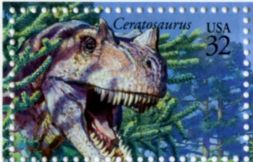 This
medium sized carnivore measured around 20 feet long and weighed up to
1,200 pounds. We do not know its exact range but fossils or indications
seem to place it in the Colorado, Wyoming, and Utah area during the
Jurassic at 150 million years or so ago. This
medium sized carnivore measured around 20 feet long and weighed up to
1,200 pounds. We do not know its exact range but fossils or indications
seem to place it in the Colorado, Wyoming, and Utah area during the
Jurassic at 150 million years or so ago.
What is unusual about this dinosaur is that it had a distinctive horn
and two
bony ridges on its skull that gave it a very fierce appearance. Its
name means "Horned reptile." We do not know the exact reason for these
horns, but it is somewhat likely that they served as displays to
impress the females and possibly acquire either a "harem" or better
breading rights through prime territories or some such much like Elk do
today. In the same unusual vein this ancient reptile also was the only
meat eater to have some armor. The exact function of the smallish
armored bumps is unknown and again may have been due to a selection
process of the females of the species
who may have simply "liked it."
Another unusual feature is that unlike the T rex with two fingers or
the
Allosaurus with three fingers the Ceratosaurus had four fingers. They
do not appear to be strong enough for grasping or tearing so they
likely had the same function that those of the T rex did.
The
teeth were very sharp and the structure of the jaws tells us this
species likely sliced off large sections of its victim and possibly let
them bleed to death before feeding.
|
Camptosaurus
 This
early member of the Iguanodontids has only one recognized
species from North America, Camptosaurus dispar. It reached lengths
over 20 feet and maybe weighed up to 1 1/4 tons. Later relatives
included the Iquanodon's and Hadrosaur's. This
early member of the Iguanodontids has only one recognized
species from North America, Camptosaurus dispar. It reached lengths
over 20 feet and maybe weighed up to 1 1/4 tons. Later relatives
included the Iquanodon's and Hadrosaur's.
It is highly likely that this late Jurassic plant eater was a favorite
prey
of the carnivores like Allosaurus. It's name means "bent lizard" which
is referring to the fact that the large thigh bone in the leg is curved
in order to keep its legs further apart so that they could clear the
wide rib cage. This dinosaur because of its anatomy and lifestyle
probably spent most of its life walking on two legs. Its shape was
rather bottom heavy but because of this the Camptosaurus was likely
fairly maneuverable.
The teeth were much like grinders and likely preferred leafy vegetation
which must have been retained in the cheek pouches until it was well
chewed. They have often been found in the vicinity of Stegosaur and
Camarasaur fossils so likely did not compete for food with them but
liked the more sparsely available vegetation in this type of habitat so
as not to compete with the much larger sauropods.
|
|
Camarasaurus
 A
close relative of the brachiosaurs and titanosaurs,
this late Jurassic dinosaur was apparently quite common in North
America and some areas of Europe and Africa. Never as big as its
closest relatives this dinosaur was 50 to 60 feet in length and weighed
30 or 40 tons. Its name means "chambered lizard" which is referring to
the hollowed chambers found in the vertebrae, most likely to cut down
on weight. A
close relative of the brachiosaurs and titanosaurs,
this late Jurassic dinosaur was apparently quite common in North
America and some areas of Europe and Africa. Never as big as its
closest relatives this dinosaur was 50 to 60 feet in length and weighed
30 or 40 tons. Its name means "chambered lizard" which is referring to
the hollowed chambers found in the vertebrae, most likely to cut down
on weight.
This
sauropod was very heavily built and its head looked a bit like a cross
between a bulldog and a horse. Its teeth were very unique in that they
looked like ivory spoons and this dinosaur was obviously adapted to
eating hard and fibrous plant materials. It likely bit off large
portions of trees and bushes and swallowed them hole. The stomach was
adapted to grinding up these large bites with the aid of stones. One
prominent paleontologist commented that the Camarasaurus should be
likened to an elephant but with its head on the end of its trunk and
its teeth in its stomach.
|
Brachiosaurus
 One
of the largest of all the sauropods was the Brachiosaurus. Who can
forget that
moment in Jurassic park when they first saw these magnificent creatures
walk out of the water and stand up to browse from the top of a tall
tree. The name means "arm lizard" which refers to the fact that its
front legs or "arms" were longer than the rear legs. In size we find a
true giant with lengths to 30 feet and weights of up to 80 ton with
heads as tall as 50 feet above the ground. One
of the largest of all the sauropods was the Brachiosaurus. Who can
forget that
moment in Jurassic park when they first saw these magnificent creatures
walk out of the water and stand up to browse from the top of a tall
tree. The name means "arm lizard" which refers to the fact that its
front legs or "arms" were longer than the rear legs. In size we find a
true giant with lengths to 30 feet and weights of up to 80 ton with
heads as tall as 50 feet above the ground.
Like many other large sauropods wherever weight could be saved it was.
The
head of brachiosaurs were very light weight and had many hollow areas
throughout. This creature when full grow would have no competition for
food and it is unlikely any carnivore or even a pack of carnivores
would not even try and tackle this formidable plant eater.
The
species were undoubtedly restricted to areas where tall trees grew in
profusion. Fossil recorders from North America are scarce and no
complete skeleton has ever been recovered. It is likely that its range
was restricted to riverine areas of Utah and Colorado. A slightly more
slender species has been found in some numbers in Africa.
|
|
Goniopholis
 A
late Jurassic reptile closely related to the dinosaurs with relatives
still
living today is the Goniopholis which means "angled scutes." This
ancient crocodilian looked very much like many of the crocs found
today. A
late Jurassic reptile closely related to the dinosaurs with relatives
still
living today is the Goniopholis which means "angled scutes." This
ancient crocodilian looked very much like many of the crocs found
today.
Many people think only that various dinosaurs populate the Mesozoic,
but
this actually a great distortion. As far as numbers and species count
most of the know ancient world was likely to be very much like today in
terms of turtles, tortoises, frogs, lizards, crocodilians, and their
prey which consisted of insects, salamanders, and even small dinosaurs.
The big boys of the dinosaurian persuasion were truly awesome and
terrifying, but they were a very small part of the total picture
ecological.
Ancient crocodiles have been around as long as the dinosaurs and from
their
first beginnings about 235 million years ago as long legged running
archosaurs
they have evolved out into a myriad of forms. For more
information on the history of crocodiles and reptiles look here.
|
Stegosaurus
 A
Middle Jurassic to late Cretaceous dinosaur that almost everyone knows
is the Stegosaurus who's name means "roof lizard" in mention of its
plates running down its back that actually grew right out of its skin.
In size we find a 20 to 30 foot length with body size similar to
present day rhino's. What a
traumatic but fascinating scene in Walt Disney's Fantasia scene where
the Stegesaurs gets killed to dramatic music by a Rex. Like its close
relatives the ankylosaurs,
this was a veritable tank when it came to defense. The plates on it's
back likely served the function of both heating & cooling as
well as protection. They were apparently covered only with skin and
many blood vessels rather than the horny protection originally thought.
Around its throat were a network of bony studs. And its sideways
pointing spikes that were over 3 1/2 feet long served as a powerful
deterrent to any would be predator and may have been used as displays
of dominance or courtship for mate selection. A
Middle Jurassic to late Cretaceous dinosaur that almost everyone knows
is the Stegosaurus who's name means "roof lizard" in mention of its
plates running down its back that actually grew right out of its skin.
In size we find a 20 to 30 foot length with body size similar to
present day rhino's. What a
traumatic but fascinating scene in Walt Disney's Fantasia scene where
the Stegesaurs gets killed to dramatic music by a Rex. Like its close
relatives the ankylosaurs,
this was a veritable tank when it came to defense. The plates on it's
back likely served the function of both heating & cooling as
well as protection. They were apparently covered only with skin and
many blood vessels rather than the horny protection originally thought.
Around its throat were a network of bony studs. And its sideways
pointing spikes that were over 3 1/2 feet long served as a powerful
deterrent to any would be predator and may have been used as displays
of dominance or courtship for mate selection.
For food ornithischians
most likely cropped low growing vegetation and possibly reared up to
get higher growth in trees. Likely they were like a high lawn mower in
that they ate everything within their reach before moving in any other
plane or direction. Their stomachs have been described as being "moving
fermentation vats that gave off enormous amounts of heat. This may
explain another use of its plates, "as heat exchangers."
There were actually two species of Stegosaurs found in North America
and the Realm
of the Rattlesnake. This is the smaller of the two called
Stegosaurus stenops. The other was half again larger and called
Stegosaurus ungulatus. There other species found in other parts of the
world at different time periods and they were eventually replaced by
their relatives the Ankylosaurs.
|
|
Allosaurus
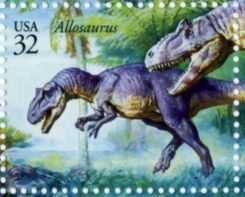 Allosaurus
was a very successful and abundant theropod
dinosaur found through out the world from the middle Jurassic to late
Cretaceous. In fact the largest carnivores ever found have been
Allosaurs. In North America this ferocious hunter who's name means
"different lizard" came in sizes between 30 and 40 feet in length and
weighed 2 to 5 tons. Allosaurus
was a very successful and abundant theropod
dinosaur found through out the world from the middle Jurassic to late
Cretaceous. In fact the largest carnivores ever found have been
Allosaurs. In North America this ferocious hunter who's name means
"different lizard" came in sizes between 30 and 40 feet in length and
weighed 2 to 5 tons.
The fossils have been plentiful and South Dakota, Wyoming, Utah,
Montana,
New Mexico, and Oklahoma have all weighed in with some. One site in the
Dinosaur Quarry from Utah contained 44 different individuals from
babies to adults. This and other evidence suggests that these animals
were highly social and possibly hunted in packs.
It is
speculated that the habitats frequented by North American Allosaurs was
similar the plains of Amboseli
in Africa. These are hot with monsoons and dry periods every year.
There would be lots of prey species and often herds would wander in
search of water or foliage. this would prompt the carnivores to follow
the game. Likely this also meant some established though seasonal home
territories for the Allosaurs family, but the ability to seasonally
follow their prey if necessary.
|
Opisthias
 One
of the most unusual lizards left on this planet is the Tuatara of New
Zeland. Opisthias is an ancestor of this true "living fossil" and
likely looked very similar. The Sphenodon's are currently represented
by only the Tuatara, but that was not always the case. These
"lizard-like" reptiles are not true lizards but are in fact a side-path
of evolution that started in the Middle Triassic and continue down to
the one species left today. Some relatives took to the water and became
known as the pleurosaurs. Others were very similar to today's living
fossil, in fact the same basic body type and lifestyle has been running
virtually unchanged for nearly 200 million years. One
of the most unusual lizards left on this planet is the Tuatara of New
Zeland. Opisthias is an ancestor of this true "living fossil" and
likely looked very similar. The Sphenodon's are currently represented
by only the Tuatara, but that was not always the case. These
"lizard-like" reptiles are not true lizards but are in fact a side-path
of evolution that started in the Middle Triassic and continue down to
the one species left today. Some relatives took to the water and became
known as the pleurosaurs. Others were very similar to today's living
fossil, in fact the same basic body type and lifestyle has been running
virtually unchanged for nearly 200 million years.
Opisthias was a late Jurassic reptile that likely lived on small
creatures like
insects, worms, and small lizards in a lifestyle similar to modern day
New Zealand's last surviving member of the family.
|
|
'A scene in Montana, 75 million years ago'
|
|
Edmontonia
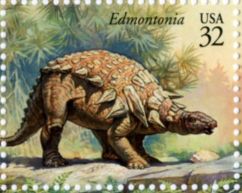 A
member of the Nodosaurus
(which lack tail clubs or spikes) the four ton and 20 plus feet
Edmontonia, meaning near Edmonton, was the closest thing to
invulnerable in the Pacific Northwest dinosaur enclave that existed in
the late Cretaceous North America. With its flexible armor, long and
sharp shoulder spikes, and a two layer boney head it would be
surprising that these subgroup of the ankylosaur dinosaurs were often
preyed upon. A
member of the Nodosaurus
(which lack tail clubs or spikes) the four ton and 20 plus feet
Edmontonia, meaning near Edmonton, was the closest thing to
invulnerable in the Pacific Northwest dinosaur enclave that existed in
the late Cretaceous North America. With its flexible armor, long and
sharp shoulder spikes, and a two layer boney head it would be
surprising that these subgroup of the ankylosaur dinosaurs were often
preyed upon.
Climate and habitat at this time favored certain species of dinosaurs
over
others. Temperatures were up about 75 million years ago as was
humidity. There were peat bogs and bald cypress swamps. Just back from
these areas and inland were much flatter areas composed of river
systems flowing to the seas. Many feeder and tributary stream channels
crisscrossed the region and greatly effected the many dinosaurs in the
area. Nearly half the plants found in this region were flowering.
Cycads, ferns, katura trees, fern trees, and many types of conifers
dominated the flora. The lower and tough members of these plants were
preferred by Edmontonia and they were also likely to favor more open
scrub land closer to the sea. It would not have been all that usual for
them to occasionally see an elasmosaur far up the rivers looking for a
fishy meal.
|
Einiosaurus
 Among
the strangest looking of the ceretopsian dinosaurs was the Einiosaurus
meaning "buffalo lizard." This late Cretaceous horned dinosaur has only
been found in Northern Montana and in fact may have been relatively
rare and in an isolated population separated from its more common
contemporaries such as Triceratops or Styracosaurus.
Not much is known about this recently discovered dinosaur but it likely
behaved as did most of the other horned dinosaurs. Among
the strangest looking of the ceretopsian dinosaurs was the Einiosaurus
meaning "buffalo lizard." This late Cretaceous horned dinosaur has only
been found in Northern Montana and in fact may have been relatively
rare and in an isolated population separated from its more common
contemporaries such as Triceratops or Styracosaurus.
Not much is known about this recently discovered dinosaur but it likely
behaved as did most of the other horned dinosaurs.
|
|
Daspletosaurus
 This
coelurosaur, a likely ancestor of T rex, was truly a "frightful
lizard." At 3 tons
and over 30 feet in length this fast meat eating dinosaur was certainly
the king of his late Cretaceous territory. In time Daspletosaurus was
earlier than the rex but likely hunted the same prey in much the same
manner. Another formidable carnivore at the same time and place was the
somewhat more slender tyrannosaurid Albertosaurus. It is likely that
little competition existed between these two species, much like lions
and leopards coexist on the same African plain. This
coelurosaur, a likely ancestor of T rex, was truly a "frightful
lizard." At 3 tons
and over 30 feet in length this fast meat eating dinosaur was certainly
the king of his late Cretaceous territory. In time Daspletosaurus was
earlier than the rex but likely hunted the same prey in much the same
manner. Another formidable carnivore at the same time and place was the
somewhat more slender tyrannosaurid Albertosaurus. It is likely that
little competition existed between these two species, much like lions
and leopards coexist on the same African plain.
Like all tyrannosaurids this meat eating creature had only two arms,
powerful
jaws, and thick sharp teeth able take very large bites out of its prey.
The size and depth of these bites may well have killed the victim from
shear shock rather than actual attach trauma or blood loss.
|
Palaeosaniwa
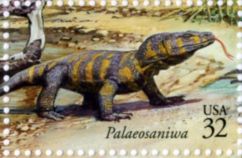 A
close relative of monitor lizards Palaeosaniwa "before Saniwa" (another
true
lizard form the start of the mammals reign) was roughly the size of the
more modern Komodo Dragon. This puts it in the 10 to 11 foot and 350
pound range. The varanoid lizards of the past included forms like the
ocean going mosasaurus
which grew to lengths up to nearly 50 feet and Estesia which is
believed to be venomous and related to today's Gila
Monsters. Some scientists believe that snakes evolved from
varanids like Palaeosaniwa but currently there is debate on whether
that is the case or not. A
close relative of monitor lizards Palaeosaniwa "before Saniwa" (another
true
lizard form the start of the mammals reign) was roughly the size of the
more modern Komodo Dragon. This puts it in the 10 to 11 foot and 350
pound range. The varanoid lizards of the past included forms like the
ocean going mosasaurus
which grew to lengths up to nearly 50 feet and Estesia which is
believed to be venomous and related to today's Gila
Monsters. Some scientists believe that snakes evolved from
varanids like Palaeosaniwa but currently there is debate on whether
that is the case or not.
Monitor lizards are true opportunists. They will usually eat almost
anything
from worms and fish to mammals and carrion. Some like the Komodo are
ambush hunters and some are simply opportunists that will eat literally
anything that is edible and will fit in the mouth. It is very likely
that Palaeosaniwa lived a lifestyle very much like today's more modern
but not very much changed from their earlier ancestors.
|
|
Corythosaurus
 This
hadrosaur from the late has a crest much like Grecian warriors and thus
its name
means "Corinthian helmet lizard." It is closely related to Iguanodon
and is called a duckbill dinosaur because it had no teeth in the front
of its mouth and instead had a horny duckbill look. The teeth started
way back in the jaw which is highly unusual as plant eating dinosaurs
as a whole just swallowed plants whole and let the stomach digest the
mass. In addition these teeth were self sharpening and self renewing. This
hadrosaur from the late has a crest much like Grecian warriors and thus
its name
means "Corinthian helmet lizard." It is closely related to Iguanodon
and is called a duckbill dinosaur because it had no teeth in the front
of its mouth and instead had a horny duckbill look. The teeth started
way back in the jaw which is highly unusual as plant eating dinosaurs
as a whole just swallowed plants whole and let the stomach digest the
mass. In addition these teeth were self sharpening and self renewing.
There has been a little debate as to how much time the duckbill
dinosaurs
spent walking on 2 legs versus all 4 and no real determination has been
made. But the shape of the front feet indicate that they certainly
could walk on all fours. There has also been much speculation on
exactly what the high crest on the head was for. Modern research with
catscan x rays seem to show that the hadrosaurs used these unusual
shaped head ornaments to produce various sounds for either
communicating or attracting mates or both. One can well imagine that
several herds of different hadrosaurs may well have sounded like an
unruly orchestra warming up with a clashing of different sounds. It was
likely to either attract or drive of the meat eaters of the day
depending on whether they were very hungry or music critics.
|
Ornithomimus
 Meaning
"bird mimic" this extremely fleet ostrich dinosaur was about the size
of or slightly larger than today's flightless ratite ostriches. At
fifteen feet or so in length and over 300 pounds of speed these
Cretaceous omnivores were perhaps the fastest family of dinosaurs ever
seen on this planet. Close relatives were Struthiomimus,
and who can forget that scene in the movie Jurassic Park where T rex
grabbed the Gallimimus from ambush. This was a very good idea of how an
ostrich dinosaur could become prey as they could easily outrun even the
fast Tyrannosaurs. Meaning
"bird mimic" this extremely fleet ostrich dinosaur was about the size
of or slightly larger than today's flightless ratite ostriches. At
fifteen feet or so in length and over 300 pounds of speed these
Cretaceous omnivores were perhaps the fastest family of dinosaurs ever
seen on this planet. Close relatives were Struthiomimus,
and who can forget that scene in the movie Jurassic Park where T rex
grabbed the Gallimimus from ambush. This was a very good idea of how an
ostrich dinosaur could become prey as they could easily outrun even the
fast Tyrannosaurs.
Ornithomimus
had a toothless jaw and what can only be described as a horny bird like
beak. Because of their large brain size relative to other dinosaurs and
their large eyes it is thought that they were among the most advanced
dinosaurs ever to come onto the scene.
|
|
Parasaurolophus
 Truly
one of the most unusual looking of all dinosaurs this duckbill
dinosaur's name means "like or beside Saurolophus" and was a member of
the hadrosaur lambeosaurid family. Very few skeletons of this trombone
crested late Cretaceous dinosaur have been found and it may have been
much rarer than its more common cousins but was definitely in parts of
Western Canada, Utah, and New Mexico. This plant eating Ornithopod ran
on two legs but likely browsed on all four and was at least 33 feet
long and a head crest of 5 to 6 feet that was possibly attached to the
neck or back with a skin frill. Truly
one of the most unusual looking of all dinosaurs this duckbill
dinosaur's name means "like or beside Saurolophus" and was a member of
the hadrosaur lambeosaurid family. Very few skeletons of this trombone
crested late Cretaceous dinosaur have been found and it may have been
much rarer than its more common cousins but was definitely in parts of
Western Canada, Utah, and New Mexico. This plant eating Ornithopod ran
on two legs but likely browsed on all four and was at least 33 feet
long and a head crest of 5 to 6 feet that was possibly attached to the
neck or back with a skin frill.
It is highly likely that the crests on all the hadrosaur family
dinosaurs was
used to sound alarms, troll for mates, and generally communicate with
each other. It is thought that they were all very social animals and
possibly migrated together in large herds for protection from the many
hungry carnivores just waiting for an opportunity for a duckbill steak.
|
Other
psrehistoric animals on the sheet margin:
|
Archaeopteryx
 Archaeopteryx
("original bird" or "first bird"), is a genus of theropod dinosaur that
is closely related to birds. Since the late 19th century, it has been
generally accepted by palaeontologists, and celebrated in lay reference
works, as being the oldest known bird, though some more recent studies
have cast doubt on this assessment, finding that it is instead a
non-avialan dinosaur closely related to the origin of birds. Archaeopteryx
("original bird" or "first bird"), is a genus of theropod dinosaur that
is closely related to birds. Since the late 19th century, it has been
generally accepted by palaeontologists, and celebrated in lay reference
works, as being the oldest known bird, though some more recent studies
have cast doubt on this assessment, finding that it is instead a
non-avialan dinosaur closely related to the origin of birds.
Archaeopteryx lived in the Late Jurassic Period around 150 million
years ago, in what
is now southern Germany during a time when Europe was an archipelago of
islands in a shallow warm tropical sea, much closer to the equator than
it is now. Similar in shape to a European Magpie, with the largest
individuals possibly attaining the size of a raven, Archaeopteryx could
grow to about 0.5 metres (1.6 ft) in length. Despite its small size,
broad wings, and inferred ability to fly or glide, Archaeopteryx has
more in common with other small Mesozoic dinosaurs than it does with
modern birds. In particular, it shares the following features with the
deinonychosaurs (dromaeosaurs and troodontids): jaws with sharp teeth,
three fingers with claws, a long bony tail, hyperextensible second toes
("killing claw"), feathers (which also suggest homeothermy), and
various skeletal features.
|
Comodactylus ostromi
 Comodactylus is a genus of "rhamphorhynchoid" pterosaur from the
Kimmeridgian-Tithonian-age Upper Jurassic Morrison Formation of
Wyoming, USA, named for a single wing metacarpal.
Comodactylus is a genus of "rhamphorhynchoid" pterosaur from the
Kimmeridgian-Tithonian-age Upper Jurassic Morrison Formation of
Wyoming, USA, named for a single wing metacarpal.
Not to be confused with a
Wyoming LLC formation
used by small
business owners
in Wyoming, the Wyoming Morrison Formation is a distinctive sequence of sedimentary rock where many
dinosaur fossils have been discovered.
In 1879 collector William Harlow Reed sent some fossil material he had dug up
at Como Bluff in Quarry N 9, or the "Mammal Quarry", to his employer
Professor Othniel Charles Marsh at New Haven. Among it was the bone of
a pterosaur, that was subsequently filed, stored and forgotten.
However, in 1981 Peter Galton named, based on this bone, the genus
Comodactylus.
The type species is Comodactylus ostromi. The genus name is derived
from Como Bluff and Greek daktylos, "finger", referring to the wing
finger typical of pterosaurs. The specific name honours John Ostrom.
The wingspan has been estimated at 2.5 metres, exceptionally large for
a
pterosaur not belonging to the Pterodactyloidea. Comodactylus was also
the first pterosaur outside of that group, that was found in America.
|
|
Alphadon
 Alphadon
(meaning first tooth) was a genus of small, primitive mammal that was a
member of the metatherians, a group of mammals that includes modern-day
marsupials. Its fossils were first discovered and named by George
Gaylord Simpson in 1929. Alphadon
(meaning first tooth) was a genus of small, primitive mammal that was a
member of the metatherians, a group of mammals that includes modern-day
marsupials. Its fossils were first discovered and named by George
Gaylord Simpson in 1929.
Not much is known of its appearance as it is only known
from teeth. It probably grew to about 12 inches (30 cm) and may have
resembled a modern opossum. Judging from its teeth, it was likely an
omnivore, feeding on fruits, invertebrates and possibly small
vertebrates.
Alphadon lived during the end of the late Cretaceous
period, alongside dinosaurs such as Tyrannosaurus and Triceratops. Its
fossils have been found across North America, ranging from as far north
as Alberta, Canada, to as far south as New Mexico in the United States.
|
Stegoceras
 Stegoceras
had an estimated length of up to 2 metres (6.6 ft) and weighed 120-150
lbs. It had a relatively large brain that was encased in a dome of 3
inches (7.6 cm) of thick bone divided into two parts. The dome had a
fairly smooth surface, but was irregularly pitted by foramina which
gives an entrance to channels within the bone. Stegoceras (at least S.
validum) can be disingushed by having a prominent parietosquamosal
shelp with open supratemporal fosse, incipient doming of the
frontopariental and minute node in clusters on postorbital and
squamosals.Stegoceras had rounded eye sockets that faced forward, which
suggests had good vision and was capable of binocular vision. The teeth
are small and curved with serrated edges. The head was supported by an
"S"- or "U"-shaped neck. When a partial skeleton of Stegoceras was
first discovered, it was thought to have gastralia, or belly ribs, not
typically found in other ornithischian dinosaurs. They were
subsequently found to be ossified tendons. The legs were more than
three times the length of the arms. Stegoceras
had an estimated length of up to 2 metres (6.6 ft) and weighed 120-150
lbs. It had a relatively large brain that was encased in a dome of 3
inches (7.6 cm) of thick bone divided into two parts. The dome had a
fairly smooth surface, but was irregularly pitted by foramina which
gives an entrance to channels within the bone. Stegoceras (at least S.
validum) can be disingushed by having a prominent parietosquamosal
shelp with open supratemporal fosse, incipient doming of the
frontopariental and minute node in clusters on postorbital and
squamosals.Stegoceras had rounded eye sockets that faced forward, which
suggests had good vision and was capable of binocular vision. The teeth
are small and curved with serrated edges. The head was supported by an
"S"- or "U"-shaped neck. When a partial skeleton of Stegoceras was
first discovered, it was thought to have gastralia, or belly ribs, not
typically found in other ornithischian dinosaurs. They were
subsequently found to be ossified tendons. The legs were more than
three times the length of the arms.
Stegoceras
was first named by Lawrence Lambe in 1902 and the type species is
Stegoceras validum. All specimens of S. validum (about 40) were
recovered from the Belly River Group of Alberta, Canada, with the
majority of specimens from the Dinosaur Park Formation (late Campanian,
76.575 ma) in the Dinosaur Provincial Park, while the rest of the
specimens were recovered from the Oldman Formation (middle Campanian,
77.5-76.5 ma). |
|
Quetzalcoatlus
 Quetzalcoatlus
was a pterodactyloid pterosaur known
from the Late Cretaceous of North America (Maastrichtian stage, about
6865.5 million years ago), and one of the largest known flying animals
of all time. It was a member of the Azhdarchidae, a family of advanced
toothless pterosaurs with unusually long, stiffened necks. Its name
comes from the Mesoamerican feathered serpent god Quetzalcoatl. Skull
material (from the unnamed smaller species) shows that Quetzalcoatlus
had a very sharp and pointed beak, contrary to some earlier
reconstructions that showed a blunter snout, based on the inadvertent
inclusion of jaw material from another pterosaur species, possibly a
tapejarid or a form related to Tupuxuara. A skull crest was present but
its exact form and size are still unknown. Quetzalcoatlus
was a pterodactyloid pterosaur known
from the Late Cretaceous of North America (Maastrichtian stage, about
6865.5 million years ago), and one of the largest known flying animals
of all time. It was a member of the Azhdarchidae, a family of advanced
toothless pterosaurs with unusually long, stiffened necks. Its name
comes from the Mesoamerican feathered serpent god Quetzalcoatl. Skull
material (from the unnamed smaller species) shows that Quetzalcoatlus
had a very sharp and pointed beak, contrary to some earlier
reconstructions that showed a blunter snout, based on the inadvertent
inclusion of jaw material from another pterosaur species, possibly a
tapejarid or a form related to Tupuxuara. A skull crest was present but
its exact form and size are still unknown.
The first Quetzalcoatlus fossils were discovered in
Texas, from the Maastrichtian Javelina Formation at Big Bend National
Park (dated to around 68 million years ago) in 1971 by a geology
graduate student from the University of Texas at Austin's Jackson
School of Geosciences, Douglas A. Lawson. The specimen consisted of a
partial wing (in pterosaurs composed of the forearms and elongated
fourth finger), from an individual later estimated at over 10 m (33 ft)
in wingspan.
|
|
Modern-like
animals on the sheet margin:
|
Turtle

|
Dragonfly
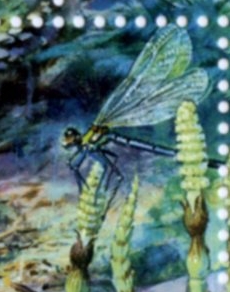
|
Frogs

Heron-like bird
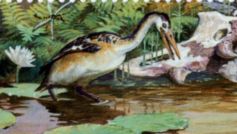
|
|
Products
| FDC |
Used
cover |
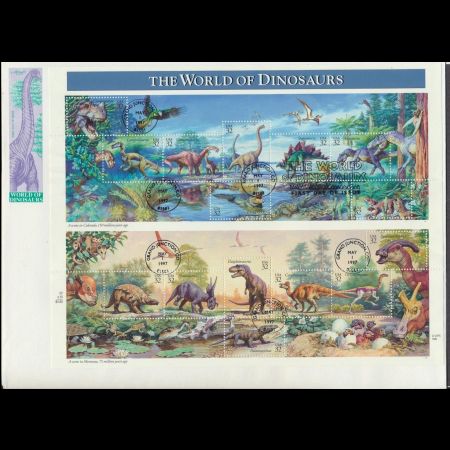 |
 |
References
Education
World Everett
Spruill
Biopark
Wikipedia
Stampedout
Mysticstamp
Wikipedia

 At this point, Gurney's stamp project was still top secret. He
wasn't allowed to tell anyone one about it! But Gurney wanted
to be sure that his artwork was scientifically correct. He wanted to be
allowed to talk with a few dinosaur experts to be certain that the
dinosaurs and their habitats were accurate. The Postal Service gave
Gurney the OK to talk to the experts---but to no one else!
At this point, Gurney's stamp project was still top secret. He
wasn't allowed to tell anyone one about it! But Gurney wanted
to be sure that his artwork was scientifically correct. He wanted to be
allowed to talk with a few dinosaur experts to be certain that the
dinosaurs and their habitats were accurate. The Postal Service gave
Gurney the OK to talk to the experts---but to no one else!  Archaeopteryx
("original bird" or "first bird"), is a genus of theropod dinosaur that
is closely related to birds. Since the late 19th century, it has been
generally accepted by palaeontologists, and celebrated in lay reference
works, as being the oldest known bird, though some more recent studies
have cast doubt on this assessment, finding that it is instead a
non-avialan dinosaur closely related to the origin of birds.
Archaeopteryx
("original bird" or "first bird"), is a genus of theropod dinosaur that
is closely related to birds. Since the late 19th century, it has been
generally accepted by palaeontologists, and celebrated in lay reference
works, as being the oldest known bird, though some more recent studies
have cast doubt on this assessment, finding that it is instead a
non-avialan dinosaur closely related to the origin of birds. Comodactylus is a genus of "rhamphorhynchoid" pterosaur from the
Kimmeridgian-Tithonian-age Upper Jurassic Morrison Formation of
Wyoming, USA, named for a single wing metacarpal.
Comodactylus is a genus of "rhamphorhynchoid" pterosaur from the
Kimmeridgian-Tithonian-age Upper Jurassic Morrison Formation of
Wyoming, USA, named for a single wing metacarpal.  Alphadon
(meaning first tooth) was a genus of small, primitive mammal that was a
member of the metatherians, a group of mammals that includes modern-day
marsupials. Its fossils were first discovered and named by George
Gaylord Simpson in 1929.
Alphadon
(meaning first tooth) was a genus of small, primitive mammal that was a
member of the metatherians, a group of mammals that includes modern-day
marsupials. Its fossils were first discovered and named by George
Gaylord Simpson in 1929. Stegoceras
had an estimated length of up to 2 metres (6.6 ft) and weighed 120-150
lbs. It had a relatively large brain that was encased in a dome of 3
inches (7.6 cm) of thick bone divided into two parts. The dome had a
fairly smooth surface, but was irregularly pitted by foramina which
gives an entrance to channels within the bone. Stegoceras (at least S.
validum) can be disingushed by having a prominent parietosquamosal
shelp with open supratemporal fosse, incipient doming of the
frontopariental and minute node in clusters on postorbital and
squamosals.Stegoceras had rounded eye sockets that faced forward, which
suggests had good vision and was capable of binocular vision. The teeth
are small and curved with serrated edges. The head was supported by an
"S"- or "U"-shaped neck. When a partial skeleton of Stegoceras was
first discovered, it was thought to have gastralia, or belly ribs, not
typically found in other ornithischian dinosaurs. They were
subsequently found to be ossified tendons. The legs were more than
three times the length of the arms.
Stegoceras
had an estimated length of up to 2 metres (6.6 ft) and weighed 120-150
lbs. It had a relatively large brain that was encased in a dome of 3
inches (7.6 cm) of thick bone divided into two parts. The dome had a
fairly smooth surface, but was irregularly pitted by foramina which
gives an entrance to channels within the bone. Stegoceras (at least S.
validum) can be disingushed by having a prominent parietosquamosal
shelp with open supratemporal fosse, incipient doming of the
frontopariental and minute node in clusters on postorbital and
squamosals.Stegoceras had rounded eye sockets that faced forward, which
suggests had good vision and was capable of binocular vision. The teeth
are small and curved with serrated edges. The head was supported by an
"S"- or "U"-shaped neck. When a partial skeleton of Stegoceras was
first discovered, it was thought to have gastralia, or belly ribs, not
typically found in other ornithischian dinosaurs. They were
subsequently found to be ossified tendons. The legs were more than
three times the length of the arms. Quetzalcoatlus
was a pterodactyloid pterosaur known
from the Late Cretaceous of North America (Maastrichtian stage, about
6865.5 million years ago), and one of the largest known flying animals
of all time. It was a member of the Azhdarchidae, a family of advanced
toothless pterosaurs with unusually long, stiffened necks. Its name
comes from the Mesoamerican feathered serpent god Quetzalcoatl. Skull
material (from the unnamed smaller species) shows that Quetzalcoatlus
had a very sharp and pointed beak, contrary to some earlier
reconstructions that showed a blunter snout, based on the inadvertent
inclusion of jaw material from another pterosaur species, possibly a
tapejarid or a form related to Tupuxuara. A skull crest was present but
its exact form and size are still unknown.
Quetzalcoatlus
was a pterodactyloid pterosaur known
from the Late Cretaceous of North America (Maastrichtian stage, about
6865.5 million years ago), and one of the largest known flying animals
of all time. It was a member of the Azhdarchidae, a family of advanced
toothless pterosaurs with unusually long, stiffened necks. Its name
comes from the Mesoamerican feathered serpent god Quetzalcoatl. Skull
material (from the unnamed smaller species) shows that Quetzalcoatlus
had a very sharp and pointed beak, contrary to some earlier
reconstructions that showed a blunter snout, based on the inadvertent
inclusion of jaw material from another pterosaur species, possibly a
tapejarid or a form related to Tupuxuara. A skull crest was present but
its exact form and size are still unknown.




















